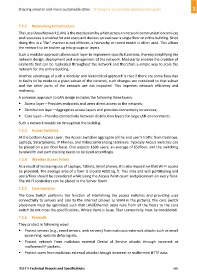Page 495 - Shaping smarter and more sustainable cities - Striving for sustainable development goals
P. 495
7.2.2 Networking Infrastructure
The Local Area Network (LAN) is the mechanism by which access to network communication services
and resources is enabled for end users and devices spread over a single floor or entire building. Since
doing this in a "flat" manner is not efficient, a hierarchy or tiered model is often used. This allows
the network to be broken up into groups or layers.
Such a modular approach allows each layer to implement specific functions, thereby simplifying the
network design, deployment and management of the network. Modularity enables the creation of
elements that can be replicated throughout the network and therefore a simple way to scale the
network for the entire building.
Another advantage of such a modular and hierarchical approach is that if there are some fixes due
to faults to be made to a given subset of the network, such changes are contained to that subset
and the other parts of the network are not impacted. This improves network efficiency and
resiliency.
A common approach to LAN design includes the following three layers:
Access layer—Provides endpoints and users direct access to the network;
Distribution layer—Aggregates access layers and provides connectivity to services;
Core layer—Provides connectivity between distribution layers for large LAN environments.
Such a network would run throughout the building.
7.2.3 Access Switches
At the bottom Access Layer, the Access Switches aggregate all the end user's traffic from Desktops,
Laptops, Smartphones, IP Phones, and Videoconferencing terminals. Typically Access Switches can
be placed on a per floor basis. One expects 1600 users, an average of 65/floor, and the switching
bandwidth and port stacking needs to be sized accordingly.
7.2.4 Wireless Access Points
As a result of increasing use of Laptops, Tablets, Smartphones, it is also imperative that Wi‐Fi access
be provided. The average area of a floor is around 4000 sq. ft. This area and wall partitioning and
users/floor should be considered while sizing the Access Point count and placement on every floor.
The Wi‐Fi controllers can be placed in the Server Room.
7.2.5 Core Switches
The Core Switch performs the function of interlinking the access switches and providing user
connectivity to servers and also to the Internet (shown as WAN in the picture). The core switch
placement must be optimized such that LAN/Ethernet cable runs from all the floors to the core
switch do not cross the specifications. Where there is issue, fiber connectivity must be considered.
7.2.6 Firewalls
They protect in following ways:
Protect servers (e.g., email servers, web servers) from malicious externals attacks such as email
spamming, website defacing etc.
Protect network from malicious external Denial of Service attacks through incorrect or
malformed IP packets.
Protect users from malicious external attacks through incorrect or malformed HTTP data.
ITU‐T's Technical Reports and Specifications 485

